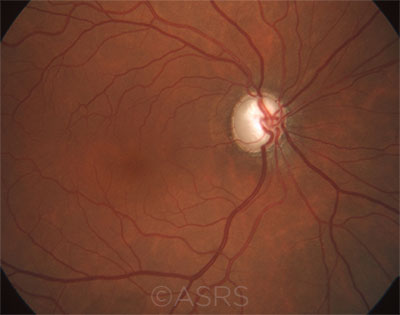Download PDF
A study to identify associations between systemic medications and primary open-angle glaucoma (POAG) found that selective serotonin reuptake inhibitors (SSRIs), a common class of antidepressant medications, were associated with a 30% reduced risk of POAG. Conversely, calcium channel blockers, a common class of antihypertensive medications, were associated with a 26% increased risk of POAG.1
“These findings are so striking [that] they merit further research to help determine whether the association is causal. If so, this could significantly change how we manage glaucoma patients, particularly those with coexisting depression or hypertension,” said Anthony P. Khawaja, PhD, FRCOphth, at Moorfields Eye Hospital in London.
 |
RETHINKING MANAGEMENT? If the association with certain drug classes holds, patients with POAG (shown here) who are taking medications for depression or hypertension may need to be managed differently. This image was originally published in the ASRS Retina Image Bank. Gerardo Garcia-Aguirre, MD. Primary Open-Angle Glaucoma—Excavated Disc. Retina Image Bank. 2013; Image Number 10964. © The American Society of Retina Specialists.
|
A needle in a haystack. Drawing on a large insurance claims database covering Jan. 1, 2007, to Dec. 31, 2014, Dr. Khawaja and his colleagues identified more than 6,100 cases of POAG in patients who had undergone at least 1 glaucoma procedure. Cases were matched in a 1:5 ratio to 30,650 controls (defined as those who had undergone a cataract procedure but had no diagnosis of glaucoma).
The database identified 423 drug classes and 1,763 generic drugs that had been prescribed over a 5-year period prior to the glaucoma procedure or cataract surgery. “The huge sample size from this type of data meant we could test for associations with all known drugs and still find significant associations that survive correction for multiple testing,” Dr. Khawaja said.
Further findings from systemic drugs. In addition to the SSRI and calcium channel blocker findings, the following associations emerged:
- Beta-blockers showed the second most significant protective association, particularly the generic metoprolol succinate. (Ophthalmic beta-blockers were excluded from the study.)
- Serotonin-norepinephrine reuptake inhibitors (SNRIs) showed a weaker—but still significant protective—association than SSRIs.
- There was a clear dose-response relationship for SSRIs, with progressively lower odds of POAG as the days of drug supply increased.
- There was no evidence of a dose response for calcium channel blockers.
Affirmations and a surprise. The association between calcium channel blockers and an increased risk of POAG corroborated a finding in the Rotterdam Study.2 “This is not a well-known association, but it is potentially very important, given the number of glaucoma patients on antihypertensive drugs,” Dr. Khawaja said. “Calcium channel blockers have even been suggested as potential treatments for glaucoma, so to clarify this relationship with further research [will be] very important.”
Given the known effects of beta-blockers on intraocular pressure, the beta-blocker finding was also not surprising. Rather, it validated the study design, Dr. Khawaja said. It also bolstered the credibility of the SSRI association, which has not been previously reported. As 22% of controls and 16% of cases were prescribed SSRIs, the association, if causal, could have a potential impact on POAG prevalence, he said.
Now Dr. Khawaja is looking for associations in other datasets. “If we replicate these findings and better characterize these associations, then further work leading toward possible pharmacological modifications of glaucoma risk will be warranted,” he said. “We are many steps away, but it is conceivable that a trial of SSRIs to slow progression of disease in POAG patients is warranted in the future.”
—Miriam Karmel
___________________________
1 Zheng W et al. Ophthalmology. 2018;125(7):984-993.
2 Müskens RP et al. Ophthalmology. 2007;114(12):2221-2226.
___________________________
Relevant financial disclosures—Dr. Khawaja: Novartis: C.
For full disclosures and the disclosure key, see below.
Full Financial Disclosures
Dr. Chévez-Barrios NASA: S.
Dr. Foster None.
Dr. Khawaja Allergan: C,L; Grafton Optical: L; Novartis: C; Thea: C.
Dr. Wirostko EyeGate: E;O.
Disclosure Category
|
Code
|
Description
|
| Consultant/Advisor |
C |
Consultant fee, paid advisory boards, or fees for attending a meeting. |
| Employee |
E |
Employed by a commercial company. |
| Speakers bureau |
L |
Lecture fees or honoraria, travel fees or reimbursements when speaking at the invitation of a commercial company. |
| Equity owner |
O |
Equity ownership/stock options in publicly or privately traded firms, excluding mutual funds. |
| Patents/Royalty |
P |
Patents and/or royalties for intellectual property. |
| Grant support |
S |
Grant support or other financial support to the investigator from all sources, including research support from government agencies (e.g., NIH), foundations, device manufacturers, and/or pharmaceutical companies. |
|
More from this month’s News in Review